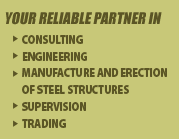| |
![]()
|
![]()
|
  |
![]()
|
![]()
|
|
|
|
![]()
|
|
![]()
|
|

Choose your language


|
|
Specific activities
Execution of specific welding activities on most important installations of the energy sector, including nuclear power plants, petrochemical industry, metallurgy, the food industry, including products of allowed materials.
Reconstruction and repair activities on tanks
Increasing the volume of already commissioned tanks
Consortium KZU Holding Group has the potential and the technologies for the increase of the capacity of already build tanks. Such a method is applied in tank farms where there is no free terrain for the erection of new tanks. The increase of the volume depends on many different factors but the volume can be increased significantly.
Replacement of corroded and defected elements
Just as any working installation tanks also wear out, but there are different standards and technologies available for replacement of single sections of tanks. Consortium KZU Holding Group applies these technologies for replacement of bottoms and first courses, which are usually most vulnerable to corrosion due to the aggressiveness of the product stored. This method allows the saving of substantial funds for the erection of new tanks, through considerable prolongation of the tank's design life.
Adding of double bottoms and double shells
Today's requirements for safe use demand the erection of additional precaution measures against possible leaks and cracks in the tanks' structure.
Examination and evaluation of tanks in use
The steel cylindrical vertical tanks for oil and petrol products are important installations. The possible destruction of such a tank could lead to serious ecological disaster. The product that is stored in them is much many times more valuable than the cost of the tank itself. Throughout the period of operation of these facilities they are exposed to the aggressive impact of the surrounding environment and the product stores in them, settlement of foundations, deformations of the structure, etc. These unfavorable factors decrease the designed life of the tank and can lead to a state when no further operation is possible. In order to avoid such cases surveys of the tanks, monitoring the current situation of the installations, should be executed on regular basis. The interval between the surveys depends on many factors such as:
- type of soil and type of foundation
- rate of foundation settlement
- sort and properties of the product stored
- results of visual survey of the tank
- presence of damages in the structure of the tanks, their type and dimensions
- change in the working conditions
but it should not exceed 10 years when considering full surveys.
Consortium KZU Holding Group executes survey, repairs and reconstruction of vertical steel cylindrical tanks which are in operation cycle. These activities increase the safety and design life of the tanks. Through surveys we can receive and process data that could determine:
- the remaining design life until next repair or decommissioning
- the type and amount of repair works exacted form the tank's technical condition
- allowed level of filling during operation
- survey of tank's structure for difficult to find flaws using the method of the acoustic emission.
Consortium KZU Holding Group owns equipment produced by the German firm Vallen for making non-destructive testing by means of the method of Acoustic emission.
The Acoustic emission method is very powerful for investigation of the behavior of materials that deform under the influence of loadings. Those materialsè 'react' to the loading and by the help of the system AMSY-5 we can listen to the 'sound' of the development of a crack, phase transformations, leaks, friction (between outer surfaces or along the surfaces of cracks), creep, tearing of reinforcing strings, tearing, corrosion, wear, discharge of condenser, cavitation, impact impulse and others. AMSY-5 is an improved ÀÅ system and has the resources to find all of these sources of ÀÅ by means of the refined sensitivity and modern 32-bite software.
The ÀÅ activity is registered as a mechanical wave and is spreading out to reach the ÀÅ sensor. In the contradiction of the sound, that is heard, every measured ÀÅ signal is transformed to electrical and that's how it can be viewed through an oscilloscope or on the display of the recording device. Usually the ÀÅ signal is appearing like one waive (waive packet or burst), which increases, reaches one or more peak amplitudes and after that dies away. The ÀÅ signal is registered above the threshold of the sound with frequency (usually from 100 to 1000 kHz) with the help of a resonance piezo-electric sensor, but AMSY-5 can work with many other sensor within the range from 5 kHz to 3 MHz.
^top
|
|
|
|
|
![]()
|
![]()
|



